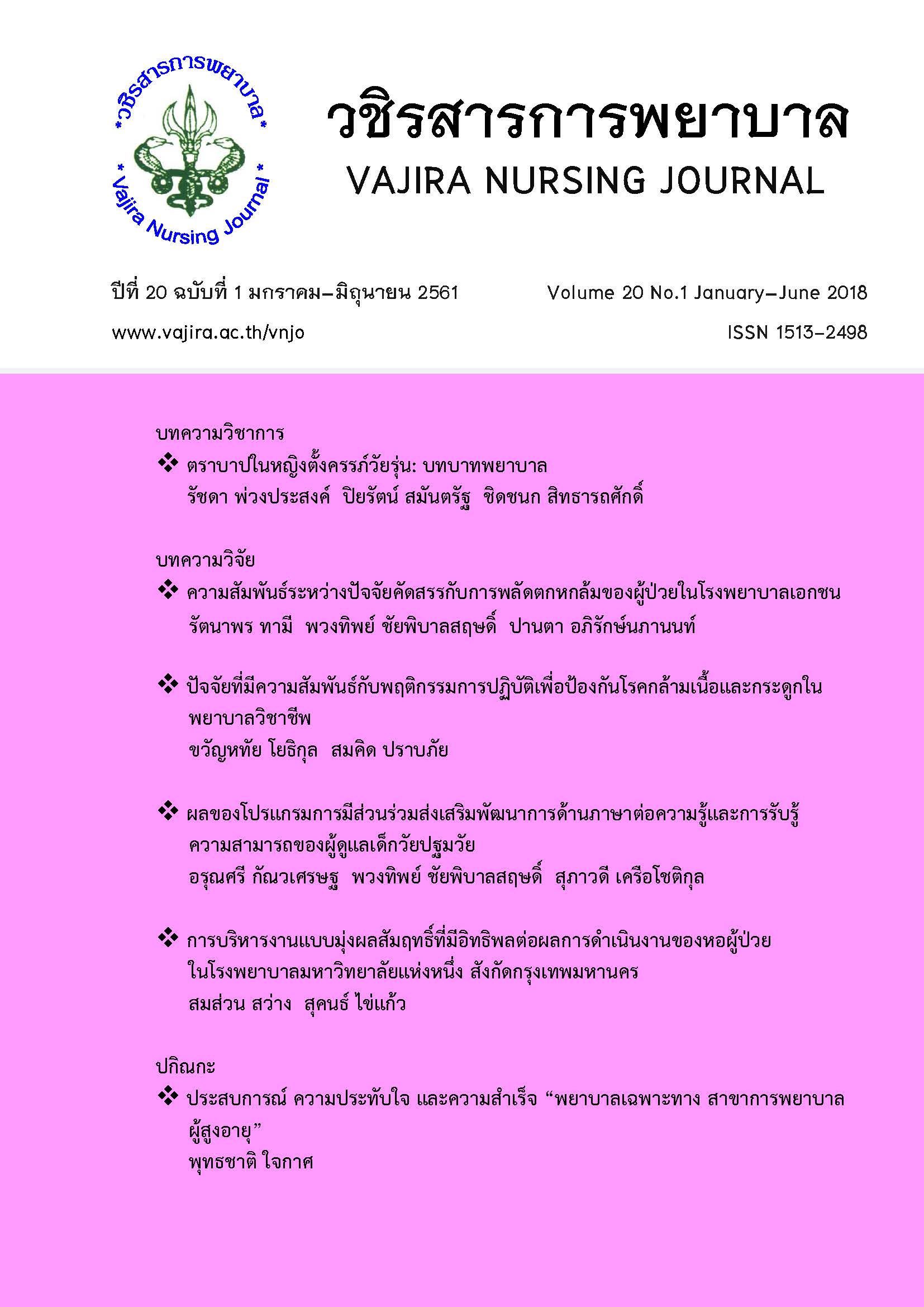ความสัมพันธ์ระหว่างปัจจัยคัดสรรกับการพลัดตกหกล้มของผู้ป่วยในโรงพยาบาลเอกชน
Main Article Content
บทคัดย่อ
การวิจัยเชิงวิเคราะห์แบบย้อนหลังจากผลไปหาเหตุ เพื่อศึกษาอุบัติการณ์และความสัมพันธ์ระหว่างปัจจัยคัดสรรกับการพลัดตกหกล้มของผู้ป่วยในโรงพยาบาลเอกชนในกรุงเทพมหานคร กลุ่มตัวอย่างคือ ผู้ป่วยที่มีอายุมากกว่า 15 ปี แบ่งเป็นกลุ่มพลัดตกหกล้ม 200 คน และกลุ่มไม่พลัดตกหกล้ม 200 คน เก็บข้อมูลระหว่างเดือนมกราคม พ.ศ.2557 – ธันวาคม พ.ศ.2559 เครื่องมือที่ใช้ในการวิจัย คือแบบบันทึกข้อมูล ประกอบด้วยข้อมูลส่วนบุคคล ข้อมูลด้านสภาพร่างกายและจิตใจ ข้อมูลด้านอุปกรณ์และสิ่งแวดล้อม และข้อมูลรายละเอียดเหตุการณ์เกี่ยวกับการพลัดตกหกล้ม และแบบประเมินระดับความเสี่ยงต่อการพลัดตกหกล้ม ค่าการตรวจสอบเชิงความตรงเท่ากับ 0.97 และความเที่ยงของเครื่องมือเท่ากับ 0.98 ผลการศึกษาอุบัติการณ์การพลัดตกหกล้มพบว่าส่วนมากร้อยละ 58.0 เกิดจากสภาพร่างกายที่คาดการณ์ได้ ร้อยละ 53.0 เกิดหลังจากนอนโรงพยาบาลในระยะ 7 วัน ร้อยละ 38.0 สถานที่เกิดเหตุพบว่าเกิดข้างเตียงผู้ป่วย และร้อยละ 37.0 เกิดขึ้นในเวรดึก โดยร้อยละ 48.0 ไม่เกิดการบาดเจ็บ ผลการวิเคราะห์ถดถอยโลจิสติกพบว่าปัจจัยที่มีความสัมพันธ์กับการพลัดตกหกล้ม (p<0.05) ได้แก่ ปัจจัยส่วนบุคคล (อายุ เพศ ประวัติการพลัดตกหกล้ม การใช้ล่ามในการสื่อสาร และระยะห่างของประเทศที่อาศัยตามเส้นแบ่งเวลา) ปัจจัยภายใน (ภาวะจิตใจ/อารมณ์ อาการสับสน/มึนงง อาการวิงเวียนบ้านหมุน ความถี่ในการขับถ่ายอุจจาระ/ปัสสาวะ การได้รับยากลุ่ม hypnotics/benzodiazepines anticonvulsants และความบกพร่องในการเคลื่อนไหวทรงตัว) และปัจจัยภายนอก (การมีญาติหรือผู้ดูแล ระยะวันนอนโรงพยาบาล และระดับความเสี่ยงต่อการพลัดตกหกล้ม) โดยปัจจัยที่สามารถร่วมทำนายโอกาสการเกิดพลัดตกหกล้มของกลุ่มตัวอย่างได้ร้อยละ 62.00 ได้แก่ เพศชาย (OR 2.48, 95%CI 1.36-4.52) ประวัติการพลัดตกหกล้ม (OR 6.72, 95%CI 1.66-27.12) สภาพจิตใจ/อารมณ์ (OR 4.75, 95%CI 1.13-18.55) ได้รับยากลุ่ม hypnotics/benzodiazepines (OR 2.08, 95%CI 1.00-4.33) anticonvulsants (OR 4.27, 95%CI 1.19-15.35) การไม่มีญาติหรือผู้ดูแล (OR 6.09, 95%CI 1.86-19.94) และระยะวันนอนโรงพยาบาลมากกว่า 7 วัน (OR 11.99, 95%CI 6.07-23.19) ผลการวิจัยนี้สามารถนำไปพัฒนาเครื่องมือเพื่อประเมินความเสี่ยงต่อการพลัดตกหกล้มสำหรับโรงพยาบาลเอกชน การนิเทศทางการพยาบาล และการพัฒนาความรู้ ทักษะของพยาบาลในการป้องกันการพลัดตกหกล้ม
Article Details
เนื้อหาและข้อมูลในบทความที่ลงตีพิมพ์ในวชิรสารการพยาบาลถือเป็นข้อคิดเห็นและความรับผิดชอบของผู้เขียนบทความโดยตรง ซึ่งกองบรรณาธิการไม่จำเป็นต้องเห็นด้วย หรือร่วมรับผิดชอบใด ๆ ทั้งสิ้น
บทความ ข้อมูล เนื้อหา รูปภาพ ฯลฯ ที่ได้รับการตีพิมพ์ในวชิรสารการพยาบาล ถือเป็นลิขสิทธิ์ของวชิรสารการพยาบาล หากบุคคลใดหรือหน่วยงานใดต้องการนำทั้งหมดหรือส่วนหนึ่งส่วนใดไปเผยแพร่ต่อหรือเพื่อกระทำการใด ๆ จะต้องได้รับอนุญาตเป็นลายลักอักษรจากวชิรสารการพยาบาลก่อนเท่านั้น
เอกสารอ้างอิง
ธารทิพย์ คนตรง, นงนุช แย้มวงษ์, นฤมล คงสาคร, และสายรุ้ง ดีนก. (2553). การพัฒนาแนวทางการประเมินภาวะเสี่ยงเพื่อป้องกันการพลัดตกหกล้มในหอผู้ป่วย. สืบค้นจาก
http://ir.swu.ac.th/xmlui/bitstream/handle/123456789/2630/Tantip_T_R402798.pdf?sequence=1
สอาด พิมพ์ปติมา, อรสา อุณหเลขกะ, ลำปาง พันธุ์จบสิงห์,นุชนาฏ กิติสิน, จีรพันธุ์ คำโสภา, ฉันทนา ธนิสสร, และคณะ. (2548). การศึกษาปัจจัยเสี่ยงและการประเมินหาระดับความเสี่ยงต่อการพลัดตกหกล้มของผู้ป่วยในงานการพยาบาลผู้ป่วยพิเศษโรงพยาบาลระดับตติยภูมิ. วารสารสภาการพยาบาล, 20(1), 75 - 87.
อภิฤดี จิวะโรจน์. (2556). การศึกษาความเสี่ยงต่อการหกล้มในผู้ป่วยโรคหลอดเลือดสมองระยะฟื้นฟูสภาพ. (พยาบาลศาสตรมหาบัณฑิต, มหาวิทยาลัยขอนแก่น).
Agency for Healthcare Research and Quality. (2013). Preventing Falls in Hospitals A Toolkit for Improving Quality of Care. Retrieved from
http://www.ahrq.gov/sites/default/files/publications/files/fallpxtoolkit.pdf.
American Nurse Association. (2007). Measuring fall program outcomes. Online Journal of issues in Nursing, 12(2). Retrieved from
http://www.nursingworld.org/MainMenuCategories/ANAMarketplace/ANAPeriodicals/OJIN/TableofContents/Volume122007/No2May07/ArticlePreviousTopic/MeasuringFallProgramOutcomes.html.
Conley, D., Schultz, A., & Selvin, R. (1999). The Challenge of Predicting Patient at Risk for Falling: Development of the Conley Scale. Medsurg Nursing, 8(6), 348-354.
Evans, D., Hodgkinson, B., Lambert, L., Wood, J., & Kowanko, I. (1998). Fall in acute hospitals a systematic review. The Joanna Briggs Institute for Evidence Base Nursing and Midwifery, Retrieved from
https://www.researchgate.net/profile/Brent_Hodgkinson/publication/253874155_Falls_in_Acute_Hospitals_ASystematic_Review/links/552b63350cf29b22c9c1a8d0.pdf.
Hendrich, A., Nyhuis, A., & Kippernbrock, T. (1995). Hospital falls: Development of predictive model for clinical practice. Applied Nursing Research, 8(3), 129-139.
Hendrich, A., Bender, P., & Nyhuis, A. (2003). Validation of the Hendrich II Fall Risk Model: A Large Concurrent Case/Control Study of Hospitalized Patients. Applied Nursing Research, 16(1), 9-21.
Hendrich, A. (2007). Predicting Patient Falls: Using the Hendrich II Fall Risk Model in clinical practice. American Journal of Nursing, 107(11), 50-58.
Hitcho, E., Krauss, M., Birge, S., Dunagan, W.C., Fischer, I., & Johnson, S. (2004). Characteristics and Circumstances of Falls in a Hospital Setting. Journal of General International Medicine, 19, 732-739.
Krauss, M.J., Evanoff, B., Hitcho, E., Ngugi, K.E., Dunagan, W.C., Fischer, I., … Fraser, V.J. (2005). A Case-control Study of Patient, Medication, and Care-related Risk Factors for Inpatient Falls Journal of General International Medicine, 20(2), 116-122.
Lahmann, N., Tannen, A., Kuntz, S., Raeder, K., Schmitz, G., & Dassen, T. (2014). Mobility is the key, Trends and associations of common care problems in German long-term care facilities from 2008 to 2012. International Journal of Nursing Studies, 52, 167-174.
Lemmer, B., Kern, R.I., Nold, G., & Lohrer, H. (2002). Jet lag in athletes after eastward and westward time-zone transition. Chronobiology International, 19(4), 743-764.
Mathias, S., Nayak, U.S., & Lsaacs, B. (1986). Balance in elderly patients: the “get-up and go” test. Arch Phys Med Rehabil, 76, 387-389.
Meijers, J., Halfens, R., Neyens, J., Luiking, Y., & Verlaan, G. (2012). Predicting falls in elderly receiving home care: The role of malnutrition and impaired mobility. The journal of nutrition, Health Aging, 16(7), 645-658.
Mion, L., Gregor, S., Buettner, M., Chwirchak, D., Lee, O., & Paras, W. (1989). Falls in the Rehabilitation Setting: Incidence and Characteristics. Rehabilitation Nursing. 14(1),
7-22.
Morse, J.M. (2009). Preventing patient falls: Establishing a Fall Intervention program (2nd ed.). New York: Springer.
Oliver, D., Britton, M., Seed, P., & Martin, F.C. (1997). Development and evaluation of evidence based risk assessment tool (STRATIFY) to predict which elderly inpatients will fall: Case-control and cohort studies. British Medical Journal, 315, doi: https://doi.org/10.1136/bmj.315.7115.1049
Oliver, D., Daly, F., Martin, F., & McMurdo, M. E. (2004). Risk factors and risk assessment tools for falls in hospital in-patients: a systematic review. Age and Ageing, 33, 122–130.
Perell, K., Nelson, A., Goldman, R., Luther, S., Lewis, N. P., & Rubenstein, L. (2001). Fall Risk Assessment Measures: An Analytic Review. The Journal of Gerontology, 56(12), 761-766.
Passaro, A., Volpato, S., Romagnoni, F., Manzoli, N., Zuliani, G., & Fellin, R. (2000). Benzodiazepines with different half-life and falling in a hospitalized population: the GIFA study. Journal of Clinical Epidemiology, 53(12), 1222-1229.
Sack, R. (2010). Clinical Practice Jet Lag. The New England Journal of Medicine, 362, 440-447.
The Joint Commission International. (2015). Sentinel Event Alert: A complimentary publication of The Joint Commission, Retrieved from
http://www.jointcommission.org/assets/1/18/SEA_55.pdf.
Waterhouse J., Reilly T., Atkinson G., & Edwards B. (2007). Jet lag: trends and coping strategies. Lancet, 369, 1117–1129.
World Health Organization. (2004). What are the main risk factors for falls amongst older people and what are the most effective interventions to prevent these falls?. Retrieved from http://www.euro.who.int/document/E82552.pdf


